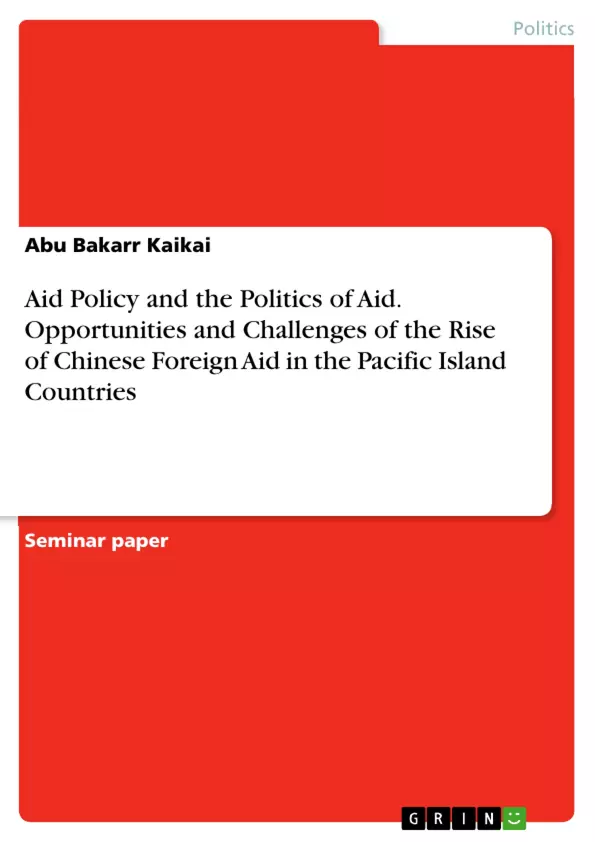This essay analyses the key stakeholders representing Chinese aid and subsequently discusses the opportunities and challenges of Chinese aid to the Islanders. It argues that Chinese aid is commercially driven. Although it has been provided for strategic interests, it has further offered new opportunities and challenges for the Pacific countries.
The essay first examines the Chinese rise and the characteristics of its international aid programmes. Next it focuses on the role of development aid in the Pacific and determines whether aid has been utilised for political gains.
Over the last two decades, China has emerged as a leading provider of development aid assistance in developing countries in Africa, Latin America and in recent times, in the Pacific Islands. China’s quest to maintain its increasing population and continue to expand its economic growth at world stage level has exacerbated China’s engagement with resource developing countries. This increasing intensification of China's development aid programme in developing countries has been prominent towards the late 1990s, mostly driven by the China ‘go out’ strategy. The ‘go out’ strategy is China’s aid model that combines both private and State-Owned Enterprises (SEOs) to venture into resource-based countries to create market-led investment through support from the Chinese government.
The overarching focus of China’s development aid is to assist other developing countries achieve their self-development objectives. The Chinese policy is framed within the context of accessibility to natural resources, such as oil, mining and gas in exchange for promoting growth in developing countries. This approach to aid seems to be changing the way development aid had been delivered. But critics of rising Chinese aid and diplomacy particularly in the Pacific Island countries are suspicious and doubtful of what Chinese motivation in Oceania could be. Some scholars, for instance Henderson and Reilly (2003), unequivocally claim that Chinese intensification in Pacific countries will destabilise the relationship between the United States and the Island countries, alluding to the Cold War between China and the US. Similarly, Windybank (2005) asserts that Chinese aid is given as a recipe to undermine Taiwan’s interest. However, others have argued that Chinese aid in the Pacific is commercially led and geared towards increasing aid visibility and providing alternatives for the Islanders, and not geopolitical in nature.
Inhaltsverzeichnis (Table of Contents)
- Introduction
- China International Aid Programme
- Chinese development aid in the South Pacific
- China in the Pacific Islands and the politics of aid
- Chinese aid and its stakeholders
- Chinese aid in the Pacific Islands: opportunities and challenges
- Conclusion
Zielsetzung und Themenschwerpunkte (Objectives and Key Themes)
This essay aims to analyze the characteristics of China's international aid program and its role in the South Pacific. It will focus on the utilization of aid for political gains and the key stakeholders involved. The essay argues that Chinese aid is commercially driven and, while provided for strategic interests, offers new opportunities and challenges for Pacific countries.
- The characteristics and objectives of China's international aid program.
- The role of Chinese development aid in the Pacific Islands.
- The key stakeholders involved in Chinese aid to the Pacific Islands.
- The opportunities and challenges presented by Chinese aid to the Pacific Islands.
- The strategic interests driving Chinese aid in the region.
Zusammenfassung der Kapitel (Chapter Summaries)
Introduction
This chapter introduces China's emergence as a leading provider of development aid in recent decades, focusing on the 'go out' strategy. The chapter discusses the motivations and objectives of China's aid program, emphasizing its focus on resource access and promoting growth in recipient countries.
China International Aid Programme
This chapter explores the characteristics of China's international aid program, outlining its principles and stakeholders. It emphasizes the use of grants, interest-free loans, and concessional loans in support of various development activities. The chapter highlights the complexities of understanding Chinese aid due to the lack of clarity between aid, investment, and trade, and the involvement of both private and state-owned enterprises.
Chinese development aid in the South Pacific
This chapter delves into the context of development aid in the Pacific Islands, noting their dependence on such programs. It explores the changing landscape of aid, with China's increasing role, and examines the critiques and narratives surrounding Chinese aid intervention in the Pacific. The chapter outlines China's stated foreign aid policy principles, focusing on self-development capacity building, non-interference, and mutual benefit.
Schlüsselwörter (Keywords)
The key terms and concepts of this essay include: Chinese development aid, 'go out' strategy, Pacific Islands, stakeholders, opportunities, challenges, strategic interests, commercial interests, win-win model, South-South cooperation, and development assistance.
- Arbeit zitieren
- Abu Bakarr Kaikai (Autor:in), 2015, Aid Policy and the Politics of Aid. Opportunities and Challenges of the Rise of Chinese Foreign Aid in the Pacific Island Countries, München, GRIN Verlag, https://www.grin.com/document/308305



